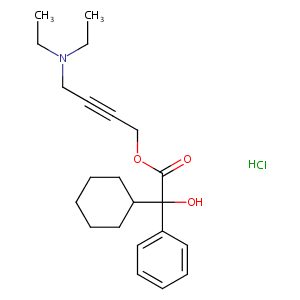Drug Information
| Drug General Information | Top | |||
|---|---|---|---|---|
| Drug ID |
D0R1DH
|
|||
| Former ID |
DIB012958
|
|||
| Drug Name |
Oxybutynin hydrochloride
|
|||
| Synonyms |
HOB-294; Oxybutynin hydrochloride (transdermal patch, overactive bladder); Oxybutynin hydrochloride (transdermal patch, overactive bladder), Hisamitsu
Click to Show/Hide
|
|||
| Drug Type |
Small molecular drug
|
|||
| Indication | Urinary incontinence [ICD-11: MF50.2; ICD-9: 788.3] | Approved | [1] | |
| Company |
Watson Pharmaceuticals
|
|||
| Structure |
 |
Download2D MOL |
||
| Formula |
C22H32ClNO3
|
|||
| Canonical SMILES |
CCN(CC)CC#CCOC(=O)C(C1CCCCC1)(C2=CC=CC=C2)O.Cl
|
|||
| InChI |
1S/C22H31NO3.ClH/c1-3-23(4-2)17-11-12-18-26-21(24)22(25,19-13-7-5-8-14-19)20-15-9-6-10-16-20;/h5,7-8,13-14,20,25H,3-4,6,9-10,15-18H2,1-2H3;1H
|
|||
| InChIKey |
SWIJYDAEGSIQPZ-UHFFFAOYSA-N
|
|||
| CAS Number |
CAS 1508-65-2
|
|||
| PubChem Compound ID | ||||
| ChEBI ID |
CHEBI:7857
|
|||
| ADReCS Drug ID | BADD_D01643 ; BADD_D01644 | |||
| Interaction between the Drug and Microbe | Top | |||
|---|---|---|---|---|
| The Metabolism of Drug Affected by Studied Microbe(s) | ||||
| The Order in the Taxonomic Hierarchy of the following Microbe(s): Bacteroidales | ||||
|
Studied Microbe: Bacteroides dorei DSM 17855
Show/Hide Hierarchy
|
[2] | |||
| Hierarchy | ||||
| Experimental Method | High-throughput screening | |||
| Description | Oxybutynin chloride can be metabolized by Bacteroides dorei DSM 17855 (log2FC = -0.518; p = 0.006). | |||
|
Studied Microbe: Bacteroides fragilis HMW 610
Show/Hide Hierarchy
|
[2] | |||
| Hierarchy | ||||
| Experimental Method | High-throughput screening | |||
| Description | Oxybutynin chloride can be metabolized by Bacteroides fragilis HMW 610 (log2FC = -0.593; p = 0.023). | |||
|
Studied Microbe: Bacteroides uniformis ATCC 8492
Show/Hide Hierarchy
|
[2] | |||
| Hierarchy | ||||
| Experimental Method | High-throughput screening | |||
| Description | Oxybutynin chloride can be metabolized by Bacteroides uniformis ATCC 8492 (log2FC = -0.545; p = 0.01). | |||
|
Studied Microbe: Bacteroides vulgatus ATCC 8482
Show/Hide Hierarchy
|
[2] | |||
| Hierarchy | ||||
| Experimental Method | High-throughput screening | |||
| Description | Oxybutynin chloride can be metabolized by Bacteroides vulgatus ATCC 8482 (log2FC = -0.469; p = 0.042). | |||
|
Studied Microbe: Bacteroides xylanisolvens DSM18836
Show/Hide Hierarchy
|
[2] | |||
| Hierarchy | ||||
| Experimental Method | High-throughput screening | |||
| Description | Oxybutynin chloride can be metabolized by Bacteroides xylanisolvens DSM18836 (log2FC = -0.459; p = 0.01). | |||
|
Studied Microbe: Odoribacter splanchnicus
Show/Hide Hierarchy
|
[2] | |||
| Hierarchy | ||||
| Experimental Method | High-throughput screening | |||
| Description | Oxybutynin chloride can be metabolized by Odoribacter splanchnicus (log2FC = -0.362; p = 0.019). | |||
| The Order in the Taxonomic Hierarchy of the following Microbe(s): Bifidobacteriales | ||||
|
Studied Microbe: Bifidobacterium ruminantium
Show/Hide Hierarchy
|
[2] | |||
| Hierarchy | ||||
| Experimental Method | High-throughput screening | |||
| Description | Oxybutynin chloride can be metabolized by Bifidobacterium ruminantium (log2FC = -0.377; p = 0.039). | |||
| The Order in the Taxonomic Hierarchy of the following Microbe(s): Erysipelotrichales | ||||
|
Studied Microbe: Eubacterium biforme DSM 3989
Show/Hide Hierarchy
|
[2] | |||
| Hierarchy | ||||
| Experimental Method | High-throughput screening | |||
| Description | Oxybutynin chloride can be metabolized by Eubacterium biforme DSM 3989 (log2FC = -0.336; p = 0.016). | |||
| The Order in the Taxonomic Hierarchy of the following Microbe(s): Eubacteriales | ||||
|
Studied Microbe: Blautia hansenii DSM20583
Show/Hide Hierarchy
|
[2] | |||
| Hierarchy | ||||
| Experimental Method | High-throughput screening | |||
| Description | Oxybutynin chloride can be metabolized by Blautia hansenii DSM20583 (log2FC = -0.539; p = 0.002). | |||
|
Studied Microbe: Clostridium sp.
Show/Hide Hierarchy
|
[2] | |||
| Hierarchy | ||||
| Experimental Method | High-throughput screening | |||
| Description | Oxybutynin chloride can be metabolized by Clostridium sp. (log2FC = -0.614; p = 0.003). | |||
| Target and Pathway | Top | |||
|---|---|---|---|---|
| Target(s) | Muscarinic acetylcholine receptor (CHRM) | Target Info | Modulator | [1], [3] |
| KEGG Pathway | Calcium signaling pathway | |||
| cAMP signaling pathway | ||||
| Neuroactive ligand-receptor interaction | ||||
| PI3K-Akt signaling pathway | ||||
| Cholinergic synapse | ||||
| Regulation of actin cytoskeleton | ||||
| Pathwhiz Pathway | Muscle/Heart Contraction | |||
| Reactome | Muscarinic acetylcholine receptors | |||
| Acetylcholine regulates insulin secretion | ||||
| G alpha (q) signalling events | ||||
| WikiPathways | Monoamine GPCRs | |||
| Calcium Regulation in the Cardiac Cell | ||||
| Regulation of Actin Cytoskeleton | ||||
| GPCRs, Class A Rhodopsin-like | ||||
| Gastrin-CREB signalling pathway via PKC and MAPK | ||||
| Secretion of Hydrochloric Acid in Parietal Cells | ||||
| GPCR ligand binding | ||||
| GPCR downstream signaling | ||||
| References | Top | |||
|---|---|---|---|---|
| REF 1 | Drugs@FDA. U.S. Food and Drug Administration. U.S. Department of Health & Human Services. 2015 | |||
| REF 2 | Mapping human microbiome drug metabolism by gut bacteria and their genes. Nature. 2019 Jun;570(7762):462-467. | |||
| REF 3 | Effects of propiverine hydrochloride (propiverine) on the muscarinic receptor binding affinity in guinea pig tissues and on salivation in conscious dogs. Nihon Yakurigaku Zasshi. 1999 Mar;113(3):157-66. | |||
If You Find Any Error in Data or Bug in Web Service, Please Kindly Report It to Dr. Zhou and Dr. Zhang.

